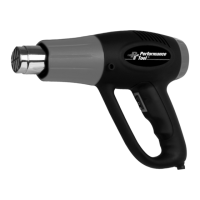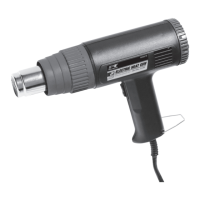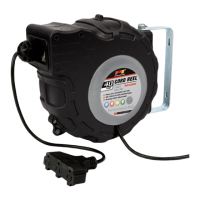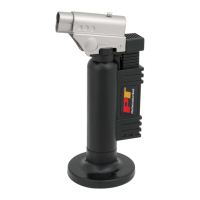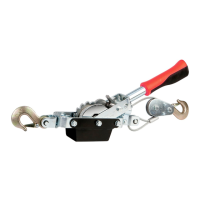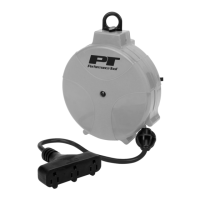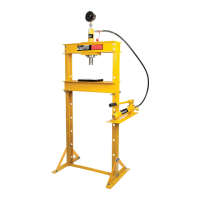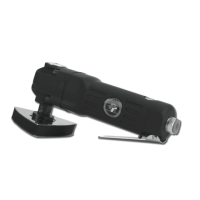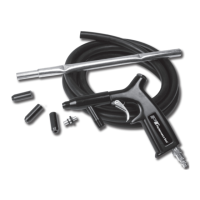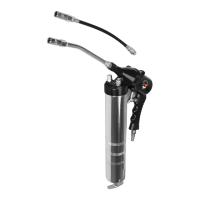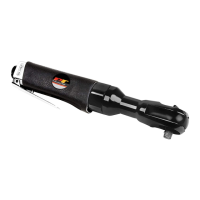3
1. Extract transmission fluid through the dipstick tube. Operate the vehicle to warm the transmission fluid, no need
to reach normal operating temperature.
2. Properly park the vehicle on level ground and turn the engine off.
3. Remove the transmission fluid dipstick.
4. Insert the appropriate diameter dipstick tube into the transmission dipstick fill hole until it reaches the bottom of
the transmission pan. Refer to step 4 above for suction probe limitations. Use the transmission dip stick as a
reference. Be sure the hose is fully inserted tightly into cap-valve.
5. Extract the used transmission fluid by pumping the evacuator handle several times to create a vacuum. Once the
fluid begins to flow into the reservoir, continue to operate the pump until all oil has been drained, or the reservoir
is full. Once the flow begins, gravity may draw the used fluid out if the evacuator is lower than the source
6. Remove suction probe from dipstick tube, remove cap valve from the reservoir, and pour the used transmission
fluid into a suitable container. Dispense the waste fluid in accordance with your local regulations.
7. Refill the transmission with new fluid in accordance with a proper vehicle maintenance guide.
8. When completed rinse the evacuator reservoir, pump, adapter, and tubes with water based solvent or engine
degreaser, and allow them to dry thoroughly.
NOTE: Due to varying fluid capacities, if the transmission capacity exceeds 8 Quarts/7.5 liters, it may be necessary
to empty the fluid reservoir before resuming the extraction process.
EXTRACTING FLUID FROM A TRANSMISSION
1. Drive the vehicle to warm the differential fluid, no need to reach normal operating temperature.
2. Properly park the vehicle on level ground and turn the engine off. Set emergency brake or chock the tires.
3. Locate and remove the drain plug from the differential. Have the EvacUflo ready with the cap valve closed and
vacuum built up by operation pump several times. With the pump handle at the top it may be difficult to operate
under the vehicle.
4. Place the suction probe in the drain hole and open the cap valve. It may be necessary to move the suction
probe around getting to the bottom of the differential to remove all the fluid. Typically differential fluid is 90
weight and may take longer to remove.
5. Refill the differential with new fluid in accordance with a proper vehicle maintenance guide.
6. When completed rinse the evacuator reservoir, pump, adapter, and tubes with water based solvent or engine
degreaser, and allow them to dry thoroughly.
NOTE: Due to varying fluid capacities, if the capacity exceeds 8 Quarts/7.5 liters, it may be necessary to empty the
fluid reservoir before resuming the extraction process.
CAUTION: Failure to allow the engine to cool before attempting to remove the cap could result in serious injuries.
Never remove the cap from the radiator or expansion tank while the engine is hot or operating. The cap will be
under pressure and the coolant may be extremely hot.
EXTRACTING OIL FROM A DIFFERENTIAL
1. Properly park the vehicle on level ground and turn the engine off.
2. Do not preheat the engine there is no need to warm the engine. Remove the radiator or expansion tank cap.
3. Insert the main suction tube into the radiator or expansion tank until it reaches the bottom, and the other end of
the hose is fully inserted tightly into cap-valve.
4. Pump the evacuator handle several times to create a vacuum, the coolant should begin to flow into the reservoir.
Continue this until the radiator is empty or the reservoir is full. Repeat if necessary.
Once the flow begins gravity may draw the used fluid out providing the Fluid Evacuator is lower than the source
EXTRACTING COOLANT FROM A RADIATOR
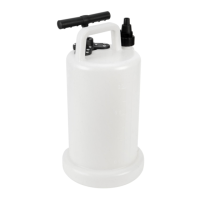
